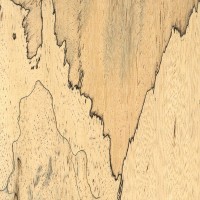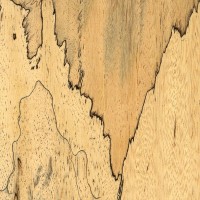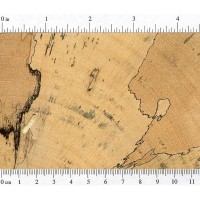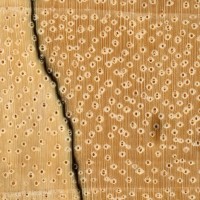 |
Common Name(s): Tamarind, Spalted Tamarind Scientific Name: Tamarindus indica Distribution: Native to tropical Africa; Tree Size: 50-80 ft (15-24 m) tall, 2-3 ft (.6-1 m) trunk diameter Average Dried Weight: 53 lbs/ft3 (850 kg/m3) Specific Gravity (Basic, 12% MC): .68, .85 Janka Hardness: 2,690 lbf (11,970 N) Modulus of Rupture: 16,090 lbf/in2 (111.0 MPa) Elastic Modulus: 1,918,000 lbf/in2 (13.22 GPa) Crushing Strength: 8,640 lbf/in2 (59.6 MPa) Shrinkage: Radial: ~3%, Tangential: ~7%, Volumetric: ~11% |
Color/Appearance: Heartwood is a deep reddish brown, sometimes with a purplish hue—heartwood portions of Tamarind tend to be narrow and are usually only present in older and larger trees. The pale yellow sapwood is very wide and sharply demarcated from the heartwood. Spalting and other discoloration are very common in the sapwood, and the majority of the Tamarind available in the United States is spalted sapwood.
Grain/Texture: Grain is wavy and interlocked with a medium uniform texture.
Endgrain: Diffuse-porous; medium to large pores in no specific arrangement, few; solitary and radial multiples of 2-3; heartwood mineral/gum deposits occasionally present;narrow rays faintly visible without lens, normal to close spacing; parenchyma vasicentric, lozenge, confluent, and banded (marginal).
Rot Resistance: Heartwood is reported to be durable to very durable regarding decay resistance, and also resistant to insect attack. Sapwood is non-durable and prone to insect and fungal attack, as well as spalting.
Workability: Because of its density and interlocked grain, Tamarind is generally considered difficult to work. Heartwood also has a pronounced blunting effect on cutting edges. Turns, glues, and finishes well—the heartwood is able to take a high natural polish.
Odor: No characteristic odor.
Allergies/Toxicity: Unspecified reports of toxicity have been reported for this wood species. See the articles Wood Allergies and Toxicity and Wood Dust Safety for more information.
Pricing/Availability: Even though older trees can attain large trunk diameters, wide boards are rare as the trunks tend to become hollow in the center. The deep reddish brown heartwood is almost never imported to the United States—the sapwood is sold much more commonly under the label “Spalted Tamarind.” Expect prices to be high for an imported tropical hardwood.
Sustainability: This wood species is not listed in the CITES Appendices or on the IUCN Red List of Threatened Species.
Common Uses: Furniture, carvings, turned objects, and other small specialty wood items.
Comments: Tamarind trees are best known for their fruit, not wood. Tamarind trees are widely planted throughout the tropics both for their fruit, and also as an ornamental.
None available.
None available.








Gorgeous spalted figuring and easy to turn and finish. The bowl blank I turned gave off a very pleasant sweet smell–it seemed like I was in a candy shop!
I just bought gauges made of tamarind wood. Theyre solid & durable, but not heavy. Love them
Using this for a mallet handle right now, pretty light, now sure how it would hold up to the abuse of an axe though. beautiful stuff. Almost done with my project and it was a dream to turn with.
Hi I am from indonesia.used spalted wood for live edge table. Unique grain.
I have many collections of this exotic Tamarind wood. It is very beautiful, my hobby is collecting this tamarind wood whenever somebody throw them away. I made this coffee table as the hard wood looks like a pouring capucino from a cettel. See how beautiful it is.
Erick – what is this table finished with?
Such beautiful wood grain, my husband make gorgeous pens out of this wood. Each one is unniqe to the spalting!!
Is the listed Janka hardness for the heartwood or the sapwood?
That’s a good question; I assume it is for heartwood as that is standard for testing. Not sure how much softer the softwood would be though…
Eric I have worked with tons of tamarind tree. They don’t produce much heartwood. It’s rarely seen and occasional distribution through out the tree. So it should be for sapwood in my opinion.
Tamarind heartwood almost same as legnum Vitae, sapwood just like soft pine.
I have to disagree. The white part is also very hard, much harder than pine. The dark part is harder than the white part. Is the dark part true heartwood or something else since it can be such a narrow part, and not uniform? It would mean the white part (what people call sap wood) is 90% of the tree which doesn’t make sense. I got a tree milled up in Thailand and it doesn’t have much of the dark wood, so that’s why I wonder about it. The tree trunk was over 3ft wide, the slabs were over 20″… Read more »
Sorry goo. I have to totally disagree with you regarding the sap wood. I haven’t used lignum vitae so can’t guarantee that. But heartwood is rock solid. The sapwood is even harder than most of the hardwoods in my case.
Could I use this wood as an axe handle
Solid-hollowed Tamarind drum shell
How hard is the sapwood compared to the heartwood?
Could it be used as flooring? My tamarind tree fell down and im not sure what to do of the tree. Like cut it to disks and lay it down on the floor?
we want to use this wood as a material for raised beds in a garden, is it capable of holding soil for a long duration?
If it is the dark red heartwood, it should be good, but if you are talking about the light-colored sapwood, it will rot.
ty
Heart wood is best for everything